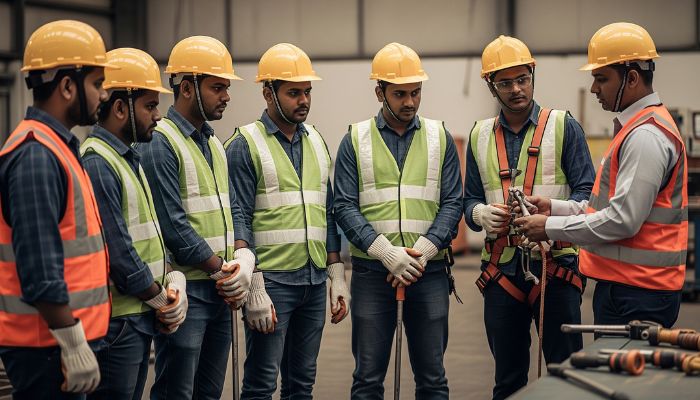In May 2025, three workers tragically died from asphyxiation while cleaning a septic tank at a dyeing unit in Karaipudur, near Tiruppur, Tamil Nadu. This tragedy exposed severe safety lapses including the absence of protective gear usage and use of hazardous manual practices. The National Human Rights Commission intervened and in response, state authorities are now prioritizing robotic tank-cleaning solutions and enforcing strict PPE usage, signalling a shift from reactive enforcement to proactive prevention. This case highlights the urgent need for modern, technology-enabled workplace safety and OSH interventions in hazardous, informal work settings.
This incident underscores a broader, ongoing effort in India to modernize Occupational Safety and Health (OSH) frameworks. India’s journey toward improving Occupational Safety and Health (OSH) is gaining significant traction, reflecting a more mature approach in ensuring worker welfare across sectors. The enactment of the Occupational Safety, Health and Working Conditions Code, 2020 marked a watershed moment in integrating 13 centralized labour laws under a comprehensive framework. Although this code has been pending implementation for over four years, recent state-level activity and technology-driven initiatives are delivering tangible momentum.
Proactive state-level implementation
In June 2025, the Gujarat government formalized the OSH and Working Conditions Code, awaiting the final nod from the central government to initiate implementation. With required safety certifications now mandatory for all operational and new establishments—ranging from factories to construction sites—Gujarat is setting a precedent for other states. Meanwhile, Karnataka has enforced the Factories (Safety Audit) Rules, 2024, instituting stricter mandates on occupiers and auditors to elevate compliance standards.
States like Kerala and Andhra Pradesh have also revamped regulations touching upon migrant workers, women’s night-shift rights, and licensing—collectively strengthening OSH oversight across domains like construction, retail, and inter‑state labour mobility.
Technology as the new vanguard
While state governments strengthen regulatory frameworks to ensure compliance, technological innovations are emerging as powerful allies in enhancing workplace safety and driving proactive risk management. Globally, and notably within India, digital innovation is redefining OSH. According to the International Labour Organization (ILO), new technologies are transforming hazard prevention practices. The adoption of AI-enabled sensors, machine-learning risk analytics, VR-based safety training, and fatigue detection systems can help to transform hazard prevention practices—helping safety management shift from being reactive to proactive regimes.
Academia is also amplifying this shift: recent research highlights the role of predictive analytics in pre-empting hazards in manufacturing, mining, and construction—a development that could inform data-driven, policy-oriented OSH reforms. On-the-ground state actions further bolster this trend; for instance, the Directorate General Factory Advice and Labour Institutes’s (DGFALI) Regional Labour Institutes conducted heat-stress awareness workshops in April–May 2025 across the cities of Chennai, Mumbai, Kolkata, and Kanpur to reinforce the urgent need for weather-risk resilience in outdoor work environments.
Tackling informality and capacity constraints
Despite these positive signals, India still grapples with significant OSH challenges. More than 80% of the workforce operates within the informal sector, where enforcement remains weak, awareness limited, and exposure to risks high. Regulatory capacities are also under strain: enforcement agencies often lack sufficient personnel and technical infrastructure to audit, monitor, or penalize violations—especially in SMEs and unregulated industries. Compounding the challenge, recent labour code amendments have faced a pushback from worker unions claiming that certain provisions dilute protections—such as those on work hours, union recognition thresholds, and strike rights. Such tensions reflect the critical imperative for inclusive, rights-oriented OSH policymaking.
Strengthening Occupational Safety and Health (OSH) Compliance
India is witnessing a renewed thrust toward Occupational Safety and Health (OSH) standards as part of a broader reformative agenda in labour compliance. In May 2025 alone, there were 68 labour-related regulatory updates, with notable amendments impacting workplace safety norms. The Maharashtra Factories (1st Amendment) Rules, 2025, exemplify this shift—mandating stricter procedural standards for industrial operations. Furthermore, Himachal Pradesh introduced changes to the Building and Other Construction Workers Rules, reinforcing OSH protocols in hazardous sectors. Karnataka’s safety audit rules, Andhra Pradesh’s labour licensing enhancements, and Kerala’s migrant- and women-sensitive OSH provisions are emblematic of a more proactive, safety-conscious regulatory ecosystem. Further, Tamil Nadu’s 2025 amendment allowing shops with 10+ employees to operate 24/7 has gone hand in hand with mandatory safety conditions—written worker consent, overtime caps, and safety protections for women—emphasizing the principle that growth and safety must progress in tandem. These updates signal a maturing compliance ecosystem where worker safety is not just a mandate but a strategic imperative aligned with global ESG benchmarks.
Shaping the next chapter of workplace safety in India
India stands at a crucial juncture in its OSH evolution. The long-awaited roll-out of the OSH Code, accelerated by proactive states like Gujarat and Karnataka, signals a tangible shift towards structured implementation. This regulatory momentum, when coupled with digital innovation, capacity expansion, and worker-led oversight, can create safer, more resilient workplaces across both formal and informal sectors.
Yet this transformation remains incomplete. Enforcing standards in the informal economy, empowering under-resourced enforcement bodies, and safeguarding worker rights must remain central to India’s OSH agenda. If pursued deliberately, with sustained investments in systems, technology, and human capital, India’s workforce can finally move toward a future where safety is not just mandated, but embedded across every dimension of work.
References:
- Guj Govt Notifies New Occupational Safety Code | Times of India
- Regulatory Compliance Newsletter | May 2025 | Mondaq
- World Day for Safety and Health at Work 2025: Role of AI and digitalisation | Business Standard
- Intelligent Approaches to Predictive Analytics in Occupational Health and Safety in India | arXiv
- ELB E-Bulletin | Volume VII – Issue III – May 2025 | Mondaq
- Monthly Compliance Roundup May 2025 I TeamLease RegTech






